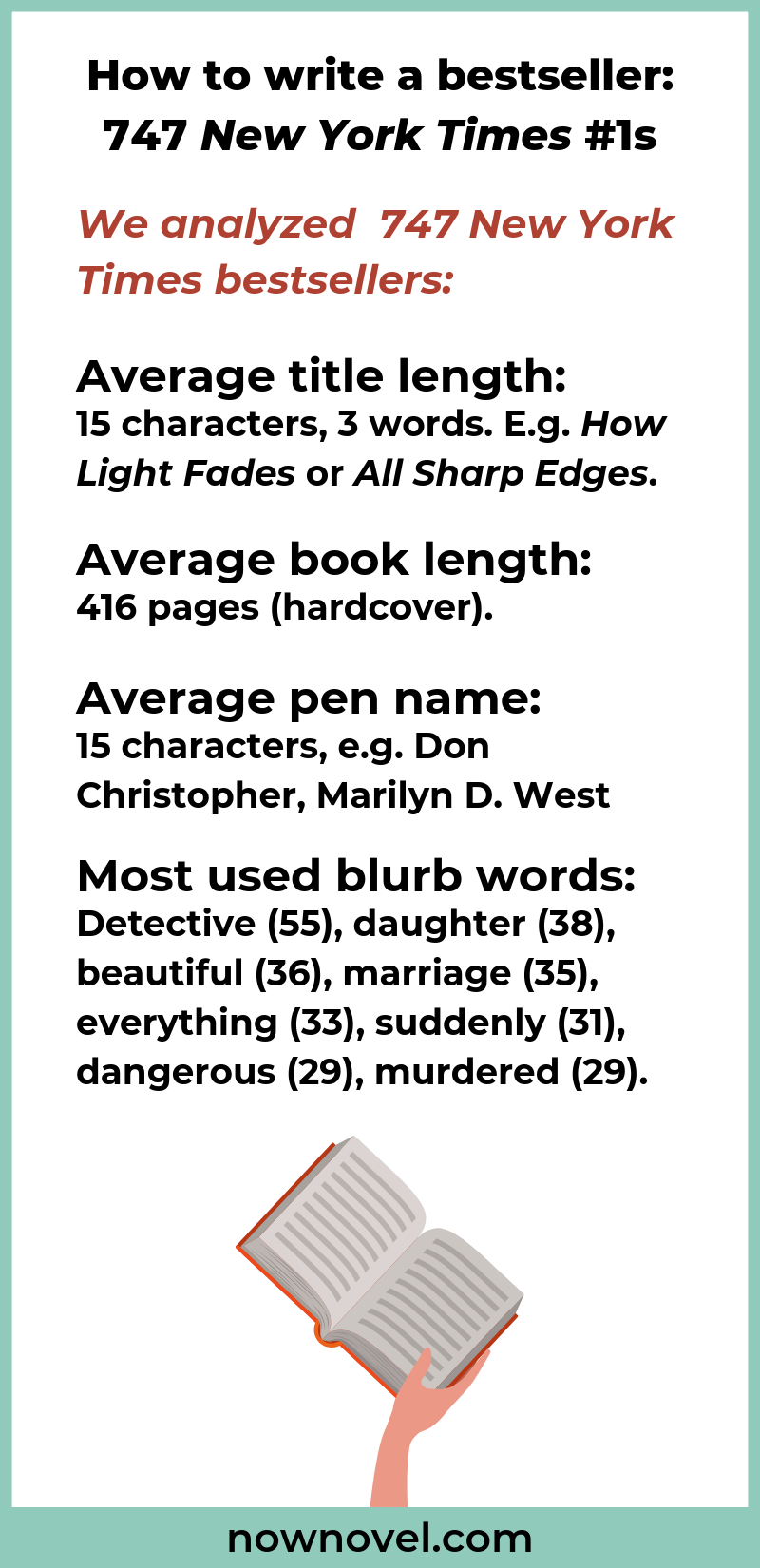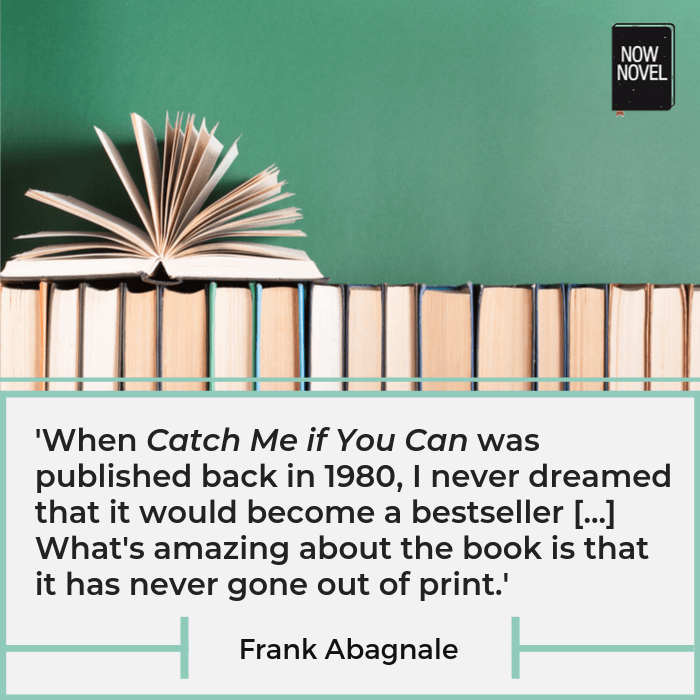Learning how to write a bestseller isn’t as simple as making sure your book ticks a few boxes. Factors influencing sales (such as marketing and readership trends) count. We analysed 747 #1 bestsellers from 1950 to share some insights into the anatomy of bestselling novels:
First, a note on limitations
Examining New York Times number ones specifically, there is naturally an American market bias in our data. We used data available from Hawes as well as Goodreads. More of the authors are of US origin than might be the case were we to use a UK-based bestseller list, for example.
We haven’t gone into gender and bestsellers either (Pudding has done a great job of that here).
What’s more, a number of authors and bloggers allege it’s possible to buy your way onto ‘top’ lists today. Thus newer rankings aren’t necessarily organic.
But read on: The list of No. 1 NYT bestsellers since 1950 is nonetheless a diverse list of novels.

1: Find a relevant story idea
Many novels, from the paranormal romance of Laurell K. Hamilton to James Patterson’s thrillers, are primarily entertainment-oriented. You won’t necessarily find dense historical detail.
However, there’s an interesting trend that emerges examining number ones from the 1950’s until now. There is a sustained trend of relevance.
In the aftermath of World War II, for example, synopses show many novels dealt with war-related themes.
Some (such as John Hersey’s The Wall (1950)) told stories of survival and courage explicitly referencing the war’s horrors.
Others used relevant details of time and place for inciting material. For example, a romance might have taken mandatory army service as the reversal or plot complication requiring resolution.
Likewise, many modern novels explore relevant, contemporary themes. The shift towards digital technology in recent decades, for example.
In Stephen King’s No. 1 bestseller Cell (2006), for example, ‘a mysterious force scrambles cellphone users’ brains.’
The arrival of the digital era as well as global fundamentalist violence are two developments in cultural history reflected in books of recent years.
So why might books relevant to the times make the number one spot?
- They feature events people are curious about or want to understand: Just as readers wanted to understand how and why the war happened, what it meant for ordinary people, today readers might be curious about our shifting technological landscape or world politics
- They use the creative potential of momentous events: A war engulfing multiple countries has many uses for stories of courage, horror, love, separation, survival. A life-changing technological development also makes rippling impact
To be relevant, your story doesn’t necessarily have to explore current events. Yet it should ideally explore a real or imagined world whose relevance to your target readership is likely.
2: Transport readers to intriguing settings
The two main elements of setting – time and place – are a big part of what will grab an audience’s interest. Understanding how to immerse your reader in an interesting place is key to how to write a bestseller (if these 747 novels are anything to go by).
If a reader doesn’t want to read about 15th Century Spain, for example, and your book’s all about it, they’ll give it a skip.
Many blurbs for the 747 No. 1 bestsellers we looked at began with immediate setting information:
A tipsy young woman seeking aid on a desolate highway disappears into the inky black night… (Jonathan Kellerman, Compulsion, 2008)
When John Sutter’s aristocratic wife killed her mafia don lover, John left America and set out in his sailboat on a three-year journey around the world, eventually settling in London. Now, ten years later, he has come home to the Gold Coast… (Nelson DeMille, The Gate House, 2008)
From a desolate highway to a global boat journey and a life spanning two continents, the settings introduced at the start of these blurbs are intriguing.
Why might a highway be ‘desolate’? What has John Sutter gained and learned (or lost) during his global adventures and temporary anchorings?
Bestsellers’ settings, if we look further, contain:
- Possibilities: A lot can happen across two continents and in a boat (or on a desolate highway)
- Atmosphere: A ‘desolate highway’ sounds like a spooky/creepy place that thrill-lovers would enjoy. Similarly, a global traveller’s story would appeal to readers who love tales of unknown destinations.
Develop interesting settings in the ‘Core Setting’ and ‘World Builder’ sections of our story outlining tool.
3: How to write a bestseller: Give readers great characters
Memorable, complex, well-drawn characters can carry an entire series.
In a Goodreads comment on a James Patterson novel, for example, one reader wrote:
I missed my loveable Alex Cross…
The review was for a novel, of course, that was not part of Patterson’s Alex Cross series.
Louise Penny’s ‘Chief Inspector Ganache’ novels (beginning with Still Life (2005)) are marketed with their protagonist’s name right beneath the title. Because the series explores a character’s continuing arc, one many readers are already invested in.
While many New York Times bestsellers’ blurbs start with setting, equally many start by introducing an interesting character:
When Willow is born with severe osteogenesis imperfecta, her parents are devastated–she will suffer hundreds of broken bones as she grows, a lifetime of pain. (Jodi Picoult, Handle with Care, 2009.)
The former F.B.I. profiler Pierce Quincy and his partner, Rainie Conner, foster a girl whose older brother murdered their drunken father. (Lisa Gardner, Right Behind You, 2017.)
Gabriel Allon, the Israeli art restorer and spy, now the head of Israel’s secret intelligence service, pursues an ISIS mastermind. (Daniel Silva, House of Spies, 2017.)
In each of these examples, we’re given key details about interesting characters upfront.
In Picoult’s novel, we know we will meet a character who faces extreme odds and we anticipate seeing how (or if) Willow’s parents will cope with this hurdle.
In Gardner’s novel, we anticipate a complex multi-character situation where a law enforcement expert will have to grapple with another type of responsibility. We also anticipate the ways this will impact his relationship with his partner.
In Silva’s example, we know interesting multiple facts about his protagonist’s profession. We are given a key character goal that will play out in the book’s pages.
To write a bestseller, make sure that even from the blurb we know interesting details about your characters. Perhaps, like Willow, we get a taste of the odds they face, or like Pierce Quincy, we know that their lives will change in enormous ways.
4: Know your genre
The majority of novels that reached No. 1 on the New York Times’ bestsellers list in the 1950s and 1960s were historical fiction. These days, mystery/thriller books tend to dominate.
Public reading and publishing tastes shift and change. Part of this is due to the mass market publishing industry’s growth. You’ll find many a thriller at your local airport’s duty-free stores, for example. Markets drive tastes even, as tastes drive markets.
Whether you’re writing epic historical fiction in the vein of James A. Michener or contemporary urban fantasy like Jim Butcher, know your genre well. If you’re not in the current ‘hot’ niche, you’ll likely need to do a little extra legwork to reach readers who are passionate about your niche subject material or themes.
Read several of the most critically acclaimed novels in your genre from the past year, as well as the bestsellers.
Knowing your own market well is essential – it also makes an impression on potential agents or publishers when you’ve done your homework.

5: Know length and other publishing requirements
There’s no set length when it comes to how to write a bestseller.
Our analysis of 747 number ones from 1950 to September 2017 revealed the average bestselling hardcover novel is approximately 416 pages long.
Yet the extremes on the list range from Slow Waltz in Cedar Bend (1993) by Robert James Waller (clocking in at 226 pages and 70,070 words) to James A. Michener’s staggeringly long historical epic Texas (1985). Michener’s epic is 1472 pages and a whopping 456,320 words.
Some publishers (e.g. Harlequin) have length requirements and expect a set formula to be used for novels in certain categories.
Browse publishers’ submission guidelines for length requirements. If in doubt, check the word counts of recently published novels of a similar genre to your own, to decide what the standard length is.
6: Develop your story with style
One thing potential publishers and readers will look for – in any genre – is interesting, structured plot development (along with character development).
Even from reading the blurbs for New York Times bestsellers we see changes and turning points:
Orphaned at an early age, Philip Ashley is raised by his benevolent older cousin, Ambrose. Resolutely single, Ambrose delights in Philip as his heir, a man who will love his grand home as much as he does himself. But the cosy world the two construct is shattered when Ambrose sets off on a trip to Florence… (Daphne du Maurier, My Cousin Rachel, 1952).
After a raid on a brothel that serviced Chicago’s elite, two people are dead and the madam’s black book has disappeared. Who is responsible? (James Patterson and David Ellis, The Black Book, 2017).
These two novels, the first by a 20th Century Gothic romance author and the second co-authored by contemporary mystery/thriller author James Patterson, both outline plot and character development right from the blurb.
Du Maurier promises familial and romantic intrigue, as well as a shift in setting that introduces new conflicts and mysteries.
Patterson and Ellis promise a suspenseful, exotic and illegal setting (a brothel). Interest in place is coupled with deaths and disappearances that must be explained.
In both cases, we see, in vague summary, an initial dramatic scenario and the promise of further revelations and surprises.
Read our post on plot development here and our post on plot twists here to give your story the turns and reversals of a timeless bestseller.
7: Choose a memorable title
The title is typically one of the last elements of your manuscript you work on. Analyzing the titles of the 747 NYT bestsellers we examined gave some insights.
For example, the average bestseller’s title is 15 characters long and 2.7 words (we rounded up to 3).
Speaking of threes, ‘the Rule of Threes’ is an idea we often find in storytelling. For one, things in threes are easier to remember. We have Julius Caesar’s alleged utterance ‘vini, vidi, vici’ (I came, I saw, I conquered). There’s ‘Hear no evil, see no evil, speak no evil’. There are the three wise men, three little pigs, three blind mice.
Some of the titles from the NYT that fit this description include:
The Black Widow by Daniel Silva, Cometh the Hour by Jeffrey Archer, 14th Deadly Sin by James Patterson & Maxine Paetro and Big Little Lies by Liane Moriarty.
In each of these cases, there are additional points of interest. There is ambiguity in ‘The Black Widow’. The title could refer to the species of spider or a widow wearing traditional black.
Since there are 7 deadly sins, doubling this number adds curiosity in Patterson and Paetro’s title. The oxymoron or contradiction in ‘Big Little Lies’ is also surprising and tension-producing.
Apart from the rule of threes, short titles are also memorable. Of course, Dave Eggers titled a fictionalized memoir A Heartbreaking Work of Staggering Genius (2000). It’s a fun, outrageous title. So ultimately, make the audacious choices you want. Be prepared to explain your reason for making them, though.
The best manuscript is a complete manuscript. You can add the polish that will make a bestseller in revisions. Finish brainstorming and planning now using Now Novel’s simple step-by-step process. Or if you have a complete draft, get a comprehensive editorial review.


One reply on “How to write a bestseller: 747 No. 1 novels”
Why isn’t this a book? I would love to see this analysis continued.